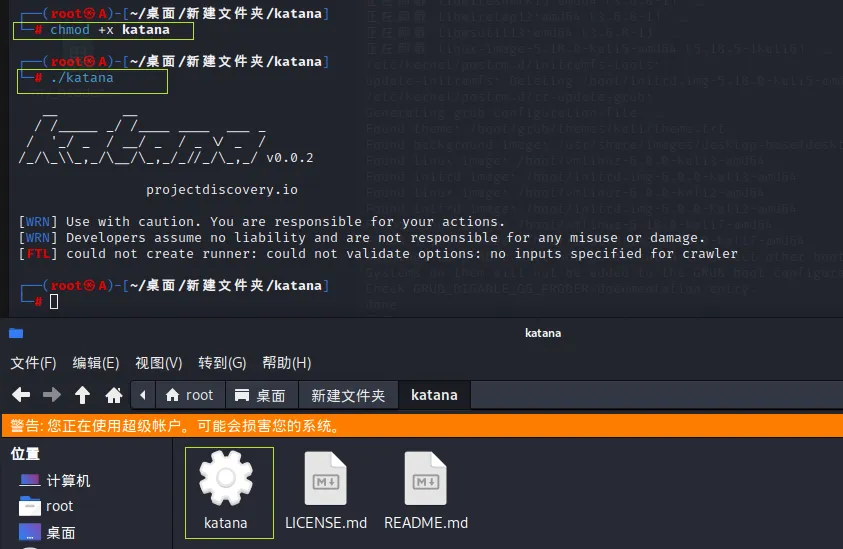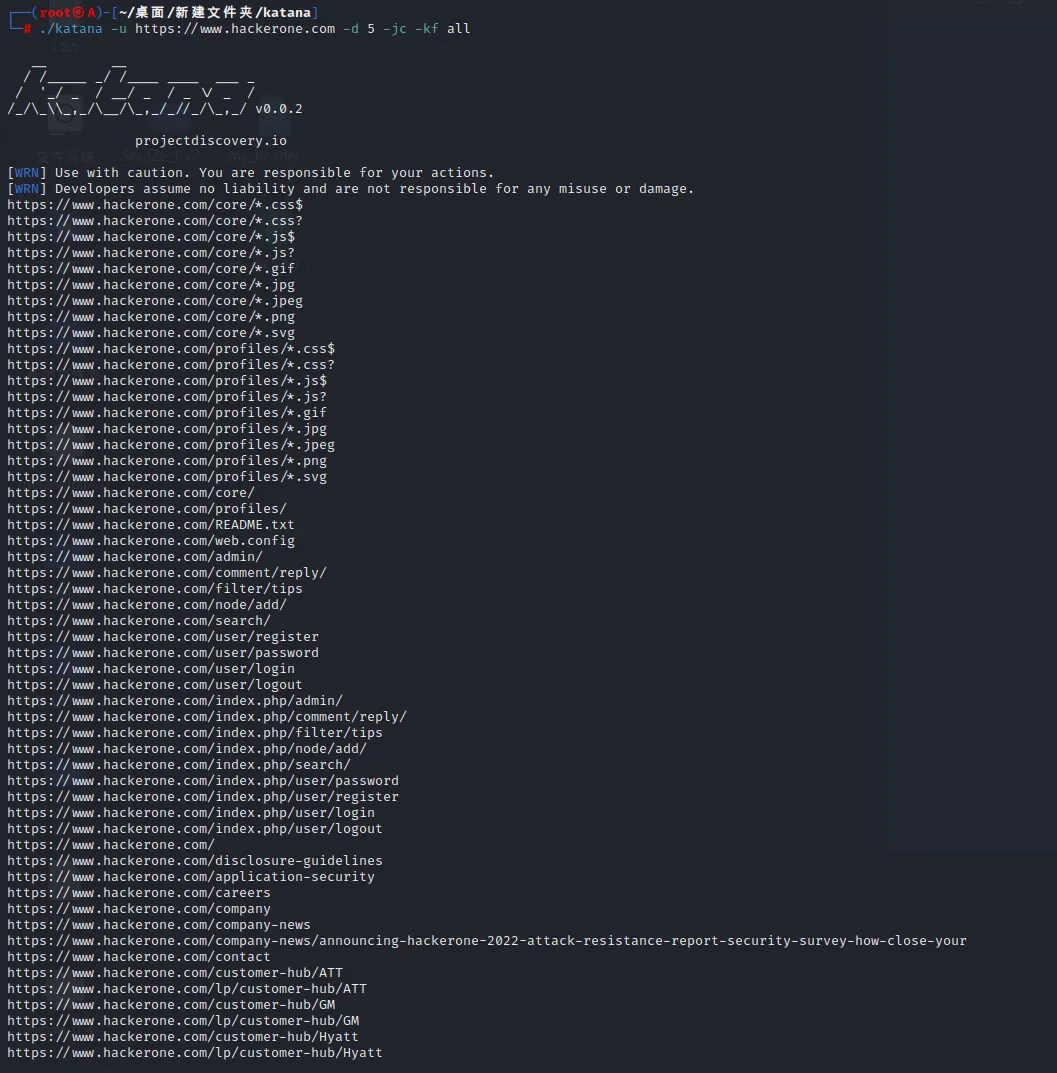目录导航
katana简介
katana是projectdiscovery项目中的一个网页链接抓取工具,可以自动解析js文件.
特色
- 快速且完全可配置,可网络升级
- 标准和无头模式支持
- JavaScript解析/刷取
- 可定制的自动填充表
- 范围控制– 预先配置文字段/正则表达式
- 可定制的输出– 预先配置文字段
- 输入 – STDIN , URL和LIST
- 输出 – STDOUT、文件和JSON
安装方法
katana 需要Go 1.18才能安装成功。
要安装,只需要运行以下指令或从发布页面下载预编译的二次制作文件。
- katana_0.0.2_linux_386.zip7.6 MB
- katana_0.0.2_linux_amd64.zip7.93 MB
- katana_0.0.2_linux_arm64.zip7.43 MB
- katana_0.0.2_linux_armv6.zip7.64 MB
- katana_0.0.2_macOS_amd64.zip8.27 MB
- katana_0.0.2_macOS_arm64.zip8.13 MB
- katana_0.0.2_windows_386.zip6.95 MB
- katana_0.0.2_windows_amd64.zip7.1 MB
go install github.com/projectdiscovery/katana/cmd/katana@latestdocker安装
安装/更新 docker 到最新 –
docker pull projectdiscovery/katana:latest
使用 docker 在标准模式下运行 katana –
docker run projectdiscovery/katana:latest -u https://tesla.com
使用 docker 以无头模式运行 katana –
docker run projectdiscovery/katana:latest -u https://tesla.com -system-chrome -headless
使用方法
katana -h
这将显示该工具的帮助。这是它支持的所有开关。
用法:
./katana [flags]
参数:
输入:
-u, -list string[] target url / list to crawl
配置:
-d, -depth int 最大爬行深度(默认为2)。
-jc, -js-crawl 在javascript文件中启用端点解析/抓取功能
-ct, -crawl-duration int 爬行目标的最长时间
-kf, -known-files string 启用对已知文件的抓取(all,robotstxt,sitemapxml)。
-mrs, -max-response-size int 读取的最大响应大小(默认为2097152)。
-timeout int 等待请求的时间,以秒为单位(默认为10)。
-aff, -automatic-form-fill 启用可选的自动填表功能(试验性的)。
-retry int 重试请求的次数(默认为1)。
-proxy string 使用的http/socks5代理
-H, -headers string[] 请求中包含的自定义头信息/cookie
-config string katana配置文件的路径
-fc, -form-config string 自定义表单配置文件的路径
无头的:
-hl, -headless 启用无头混合爬行(实验性)
-sc, -system-chrome 使用本地安装的chrome浏览器,而不是katana自带的。
-sb, -show-browser 以无头模式在屏幕上显示浏览器
-ho, -headless-options string[] 开始使用带有额外选项的无头浏览器
-nos, -no-sandbox 在无沙盒模式下启动无头的Chrome
范围:
-cs, -crawl-scope string[] 在范围内的URL重词将被爬虫遵循
-cos, -crawl-out-scope string[] 被爬虫排除的超范围的URL重词
-fs, -field-scope string 预定义的范围字段(dn,rdn,fqdn)(默认为 "rdn")。
-ns, -no-scope 禁用基于主机的默认范围
-do, -display-out-scope 从范围内抓取显示外部端点
过滤器:
-f, -field string 输出中显示的字段 (url,path,fqdn,rdn,rurl,qurl,qpath,file,key,value,kv,dir,udir)
-sf, -store-field string 储存在每个主机输出中的字段 (url,path,fqdn,rdn,rurl,qurl,qpath,file,key,value,kv,dir,udir)
-em, -extension-match string[] 匹配给定扩展名的输出(例如,-em php,html,js)。
-ef, -extension-filter string[] 过滤给定扩展名的输出(例如,-ef png,css)。
速率限制:
-c, -concurrency int 使用的并发取物器的数量(默认为10)。
-p, -parallelism int 要处理的并发输入的数量(默认为10)。
-rd, -delay int 每个请求之间的延迟,以秒为单位
-rl, -rate-limit int 每秒发送的最大请求数(默认为150)。
-rlm, -rate-limit-minute int 每分钟发送的最大请求数
输出:
-o, -output string 文件输出到
-j, -json 以JSONL(ines)格式输出
-nc, -no-color 禁用输出内容着色(ANSI转义代码)。
-silent 仅显示输出
-v, -verbose 展示粗略的输出
-version 显示项目版本katana使用示例
katana需要url或端点来抓取并接受单个或多个输入。
可以使用 URL -u选项提供输入,可以使用逗号分隔的输入提供多个值,类似地,使用选项支持文件-list输入,另外还支持管道输入 (stdin)。
网址输入
katana -u https://tesla.com
多个URL 输入(逗号分隔)
katana -u https://tesla.com,https://google.com
列表输入
$ cat url_list.txt https://tesla.com https://google.com
katana -list url_list.txtSTDIN(管道)输入
echo https://tesla.com | katana
cat domains | httpx | katana
运行起来是这个样子的:
katana -u https://youtube.com
__ __
/ /_____ _/ /____ ____ ___ _
/ '_/ _ / __/ _ / _ \/ _ /
/_/\_\\_,_/\__/\_,_/_//_/\_,_/ v0.0.1
projectdiscovery.io
[WRN] Use with caution. You are responsible for your actions.
[WRN] Developers assume no liability and are not responsible for any misuse or damage.
https://www.youtube.com/
https://www.youtube.com/about/
https://www.youtube.com/about/press/
https://www.youtube.com/about/copyright/
https://www.youtube.com/t/contact_us/
https://www.youtube.com/creators/
https://www.youtube.com/ads/
https://www.youtube.com/t/terms
https://www.youtube.com/t/privacy
https://www.youtube.com/about/policies/
https://www.youtube.com/howyoutubeworks?utm_campaign=ytgen&utm_source=ythp&utm_medium=LeftNav&utm_content=txt&u=https%3A%2F%2Fwww.youtube.com%2Fhowyoutubeworks%3Futm_source%3Dythp%26utm_medium%3DLeftNav%26utm_campaign%3Dytgen
https://www.youtube.com/new
https://m.youtube.com/
https://www.youtube.com/s/desktop/4965577f/jsbin/desktop_polymer.vflset/desktop_polymer.js
https://www.youtube.com/s/desktop/4965577f/cssbin/www-main-desktop-home-page-skeleton.css
https://www.youtube.com/s/desktop/4965577f/cssbin/www-onepick.css
https://www.youtube.com/s/_/ytmainappweb/_/ss/k=ytmainappweb.kevlar_base.0Zo5FUcPkCg.L.B1.O/am=gAE/d=0/rs=AGKMywG5nh5Qp-BGPbOaI1evhF5BVGRZGA
https://www.youtube.com/opensearch?locale=en_GB
https://www.youtube.com/manifest.webmanifest
https://www.youtube.com/s/desktop/4965577f/cssbin/www-main-desktop-watch-page-skeleton.css
https://www.youtube.com/s/desktop/4965577f/jsbin/web-animations-next-lite.min.vflset/web-animations-next-lite.min.js
https://www.youtube.com/s/desktop/4965577f/jsbin/custom-elements-es5-adapter.vflset/custom-elements-es5-adapter.js
https://www.youtube.com/s/desktop/4965577f/jsbin/webcomponents-sd.vflset/webcomponents-sd.js
https://www.youtube.com/s/desktop/4965577f/jsbin/intersection-observer.min.vflset/intersection-observer.min.js
https://www.youtube.com/s/desktop/4965577f/jsbin/scheduler.vflset/scheduler.js
https://www.youtube.com/s/desktop/4965577f/jsbin/www-i18n-constants-en_GB.vflset/www-i18n-constants.js
https://www.youtube.com/s/desktop/4965577f/jsbin/www-tampering.vflset/www-tampering.js
https://www.youtube.com/s/desktop/4965577f/jsbin/spf.vflset/spf.js
https://www.youtube.com/s/desktop/4965577f/jsbin/network.vflset/network.js
https://www.youtube.com/howyoutubeworks/
https://www.youtube.com/trends/
https://www.youtube.com/jobs/
https://www.youtube.com/kids/爬行模式
标准模式
标准爬行模式使用标准的 go http 库来处理 HTTP 请求/响应。这种模式要快得多,因为它没有浏览器开销。尽管如此,它仍按原样分析 HTTP 响应主体,没有任何 javascript 或 DOM 渲染,可能会丢失复杂 Web 应用程序中可能发生的后 dom 渲染端点或异步端点调用,例如,取决于特定于浏览器的事件。
无头模式
无头模式挂钩内部无头调用以直接在浏览器上下文中处理 HTTP 请求/响应。这有两个好处:
- HTTP 指纹(TLS 和用户代理)将客户端完全识别为合法浏览器
- 更好的覆盖率,因为发现端点分析标准原始响应,如在以前的模式中,以及启用 javascript 的浏览器呈现的响应。
无头爬行是可选的,可以使用-headless选项启用。
这是其他无头 CLI 选项 –
katana -h headless Flags: 无头的: -hl, -headless 启用无头混合爬行(实验性) -sc, -system-chrome 使用本地安装的chrome浏览器,而不是katana自带的。 -sb, -show-browser 以无头模式在屏幕上显示浏览器 -ho, -headless-options string[] 开始使用带有额外选项的无头浏览器 -nos, -no-sandbox 在无沙盒模式下启动无头的Chrome
-no-sandbox
使用no-sandbox选项运行 headless chrome 浏览器,在以 root 用户身份运行时很有用。
katana -u https://tesla.com -headless -no-sandbox
-headless-options
在无头模式下爬行时,可以使用 指定额外的 chrome 选项-headless-options,例如 –
katana -u https://tesla.com -headless -system-chrome -headless-options --disable-gpu,proxy-server=http://127.0.0.1:8080
范围控制
如果没有范围,爬行可能是无止境的,因为 katana 提供了多种支持来定义爬行范围。
-field-scope
使用预定义字段名称定义范围的最方便的选项,rdn是字段范围的默认选项。
rdn– 抓取范围为根域名和所有子域(默认)fqdn– 爬行范围为给定的子(域)dn– 抓取范围为域名关键字
katana -u https://tesla.com -fs dn
-crawl-scope
对于高级范围控制,-cs可以使用正则表达式支持附带的选项。
katana -u https://tesla.com -cs login
对于范围内的多个规则,可以传递带有多行字符串/正则表达式的文件输入。
$ cat in_scope.txt login/ admin/ app/ wordpress/
katana -u https://tesla.com -cs in_scope.txt
-crawl-out-scope
为了定义不抓取的内容,-cos可以使用选项并且还支持正则表达式输入。
katana -u https://tesla.com -cos logout
对于多个超出范围的规则,可以传递多行字符串/正则表达式的文件输入。
$ cat out_of_scope.txt /logout /log_out
katana -u https://tesla.com -cos out_of_scope.txt
-no-scope
Katana 默认为 scope *.domain,可以使用禁用此-ns选项以及抓取互联网。
katana -u https://tesla.com -ns
-display-out-scope
默认情况下,当使用 scope 选项时,它还适用于显示为输出的链接,因为此类外部 URL 默认排除并覆盖此行为,该-do选项可用于显示目标范围 URL 中存在的所有外部 URL /端点。
katana -u https://tesla.com -do这是范围控制的所有 CLI 选项 –
katana -h scope Flags: 范围: -cs, -crawl-scope string[] 在范围内的URL重词将被爬虫遵循 -cos, -crawl-out-scope string[] 被爬虫排除的超范围的URL重词 -fs, -field-scope string 预定义的范围字段(dn,rdn,fqdn)(默认为 "rdn")。 -ns, -no-scope 禁用基于主机的默认范围 -do, -display-out-scope 从范围内抓取显示外部端点
爬虫配置
Katana 带有多个选项,可以按照我们想要的方式配置和控制爬网。
-depth
定义depth跟随 url 进行爬网的选项,深度越深,被爬网的端点数量越多 + 爬网时间越长。
katana -u https://tesla.com -d 5-js-crawl
启用 JavaScript 文件解析 + 抓取在 JavaScript 文件中发现的端点的选项,默认情况下禁用。
katana -u https://tesla.com -jc-crawl-duration
预定义爬网持续时间的选项,默认情况下禁用。
katana -u https://tesla.com -ct 2-known-files
启用爬网robots.txt和sitemap.xml文件的选项,默认情况下禁用。
katana -u https://tesla.com -kf robotstxt,sitemapxml-automatic-form-fill
为已知/未知字段启用自动表单填充的选项,可以根据需要通过更新表单配置文件自定义已知字段值$HOME/.config/katana/form-config.yaml。
自动填表是实验性的功能。
-aff, -automatic-form-fill enable optional automatic form filling (experimental)需要时可以配置更多选项,这里是所有与配置相关的 CLI 选项 –
katana -h config Flags: 配置: -d, -depth int 最大爬行深度(默认为2)。 -jc, -js-crawl 在javascript文件中启用端点解析/抓取功能 -ct, -crawl-duration int 爬行目标的最长时间 -kf, -known-files string 启用对已知文件的抓取(all,robotstxt,sitemapxml)。 -mrs, -max-response-size int 读取的最大响应大小(默认为2097152)。 -timeout int 等待请求的时间,以秒为单位(默认为10)。 -aff, -automatic-form-fill 启用可选的自动填表功能(试验性的)。 -retry int 重试请求的次数(默认为1)。 -proxy string 使用的http/socks5代理 -H, -headers string[] 请求中包含的自定义头信息/cookie -config string katana配置文件的路径 -fc, -form-config string 自定义表单配置文件的路径
过滤器
-field
Katana 带有内置字段,可用于过滤所需信息的输出,-f选项可用于指定任何可用字段。
-f, -field string 输出中显示的字段 (url,path,fqdn,rdn,rurl,qurl,qpath,file,key,value,kv,dir,udir)这是一个表格,其中包含每个字段的示例以及使用时的预期输出 –
| 领域 | 描述 | 例子 |
|---|---|---|
url | 网址端点 | https://admin.projectdiscovery.io/admin/login?user=admin&password=admin |
qurl | 包含查询参数的 URL | https://admin.projectdiscovery.io/admin/login.php?user=admin&password=admin |
qpath | 包含查询参数的路径 | /login?user=admin&password=admin |
path | 网址路径 | https://admin.projectdiscovery.io/admin/login |
fqdn | 完全合格的域名 | admin.projectdiscovery.io |
rdn | 根域名 | projectdiscovery.io |
rurl | 根网址 | https://admin.projectdiscovery.io |
file | URL 中的文件名 | login.php |
key | URL 中的参数键 | user,password |
value | URL 中的参数值 | admin,admin |
kv | Keys=URL中的值 | user=admin&password=admin |
dir | 网址 目录名称 | /admin/ |
udir | 带目录的 URL | https://admin.projectdiscovery.io/admin/ |
这是使用字段选项仅显示其中包含查询参数的所有网址的示例 –
katana -u https://tesla.com -f qurl -silent
https://shop.tesla.com/en_au?redirect=no
https://shop.tesla.com/en_nz?redirect=no
https://shop.tesla.com/product/men_s-raven-lightweight-zip-up-bomber-jacket?sku=1740250-00-A
https://shop.tesla.com/product/tesla-shop-gift-card?sku=1767247-00-A
https://shop.tesla.com/product/men_s-chill-crew-neck-sweatshirt?sku=1740176-00-A
https://www.tesla.com/about?redirect=no
https://www.tesla.com/about/legal?redirect=no
https://www.tesla.com/findus/list?redirect=no
-store-field
为了补充field在运行时过滤输出有用的选项,有一个-sf, -store-fields选项与字段选项完全一样,除了不是过滤,它将所有信息存储在磁盘上katana_output按目标 url 排序的目录下。
katana -u https://tesla.com -sf key,fqdn,qurl -silent$ ls katana_output/ https_www.tesla.com_fqdn.txt https_www.tesla.com_key.txt https_www.tesla.com_qurl.txt
注意:store-field选项可以方便地收集信息来为以下内容构建目标感知词表,但不限于 -大多数/常用参数大多数/常用路径大多数/常用文件相关/未知子(域) |
-extension-match
使用选项可以轻松匹配抓取输出-em以确保仅显示包含给定扩展名的输出。
katana -u https://tesla.com -silent -em js,jsp,json-extension-filter
-ef可以使用确保删除包含给定扩展名的所有 url 的选项轻松过滤抓取输出以获取特定扩展名。
katana -u https://tesla.com -silent -ef css,txt,md这是其他过滤器选项 –
过滤器: -f, -field string 输出中显示的字段 (url,path,fqdn,rdn,rurl,qurl,qpath,file,key,value,kv,dir,udir) -sf, -store-field string 储存在每个主机输出中的字段 (url,path,fqdn,rdn,rurl,qurl,qpath,file,key,value,kv,dir,udir) -em, -extension-match string[] 匹配给定扩展名的输出(例如,-em php,html,js)。 -ef, -extension-filter string[] 过滤给定扩展名的输出(例如,-ef png,css)。
速率限制和延迟
如果不遵循目标网站限制,在爬行时很容易被阻止/禁止,katana 带有多个选项来调整爬行以达到我们想要的快/慢。
-delay
在 katana 爬行时发出的每个新请求之间引入以秒为单位的延迟的选项,默认情况下禁用。
katana -u https://tesla.com -delay 20-concurrency
用于控制每个目标同时获取的 url 数量的选项。
katana -u https://tesla.com -c 20-parallelism
用于定义要从列表输入同时处理的目标数量的选项。
katana -u https://tesla.com -p 20-rate-limit
用于定义每秒可以发出的最大请求数的选项。
katana -u https://tesla.com -rl 100-rate-limit-minute
用于定义每分钟可以发出的最大请求数的选项。
katana -u https://tesla.com -rlm 500这是用于速率限制控制的所有长/短 CLI 选项 –
katana -h rate-limit Flags: 速率限制: -c, -concurrency int 使用的并发取物器的数量(默认为10)。 -p, -parallelism int 要处理的并发输入的数量(默认为10)。 -rd, -delay int 每个请求之间的延迟,以秒为单位 -rl, -rate-limit int 每秒发送的最大请求数(默认为150)。 -rlm, -rate-limit-minute int 每分钟发送的最大请求数
输出
-json
Katana 既支持纯文本格式的文件输出,也支持 JSON,后者包括附加信息,如source、tag和attribute名称,以将发现的端点关联起来。
katana -u https://example.com -json -do | jq .
{
"timestamp": "2022-11-05T22:33:27.745815+05:30",
"endpoint": "https://www.iana.org/domains/example",
"source": "https://example.com",
"tag": "a",
"attribute": "href"
}以下是与输出相关的其他 CLI 选项 –
katana -h output 输出: -o, -output string 文件输出到 -j, -json 以JSONL(ines)格式输出 -nc, -no-color 禁用输出内容着色(ANSI转义代码)。 -silent 仅显示输出 -v, -verbose 展示粗略的输出 -version 显示项目版本
kali使用测试
[1]安装go
apt install golang-go[2]直接下载或使用下面的命令下载katana_0.0.2_linux_amd64.zip
go install github.com/projectdiscovery/katana/cmd/katana@latest[3]给权限
chmod +x katana[4]运行
./katana
[5]拿hackerone试试水
./katana -u https://www.hackerone.com -d 5 -jc -kf all
具体的最优策略自行摸索.
项目地址:
GitHub:
https://github.com/projectdiscovery/katana
转载请注明出处及链接

